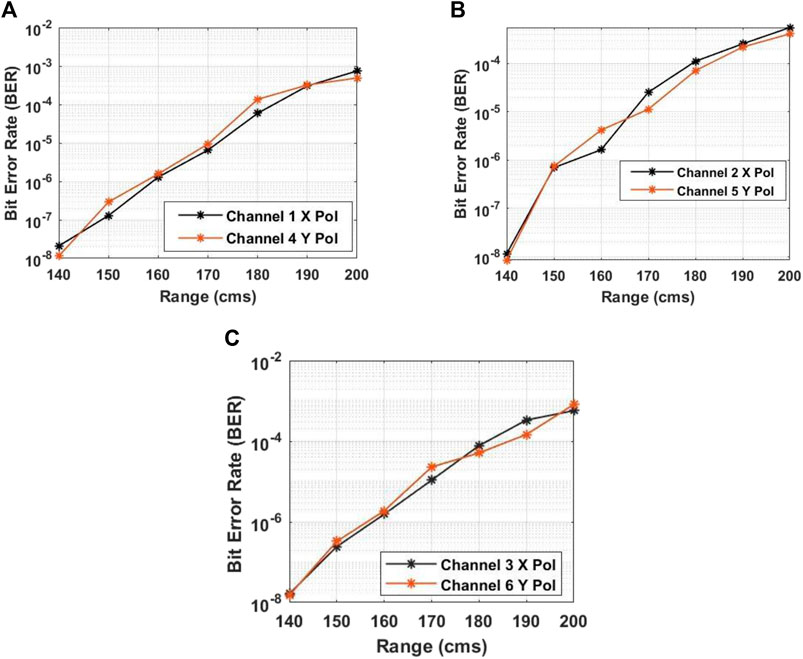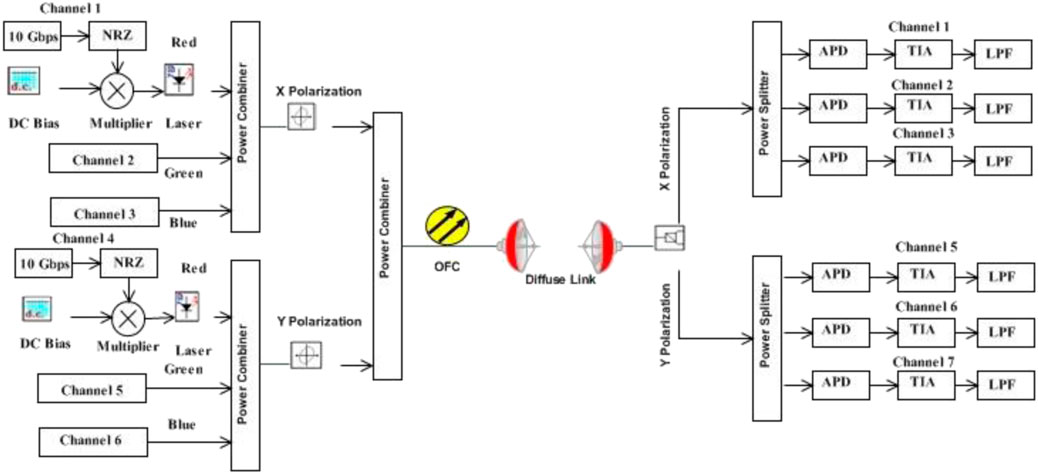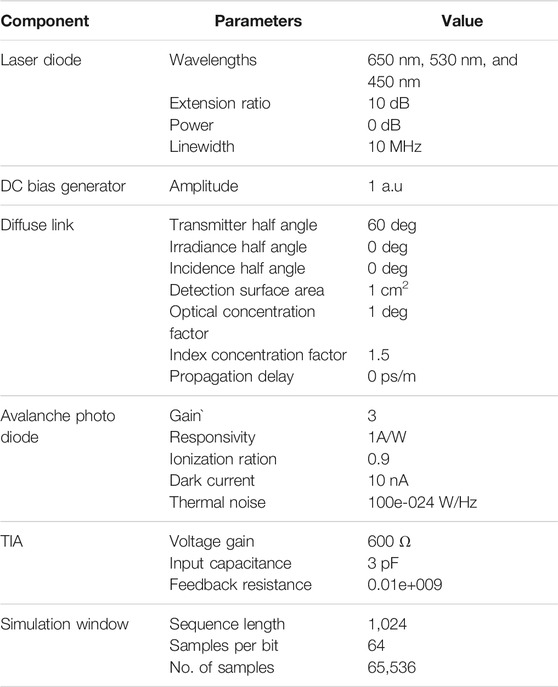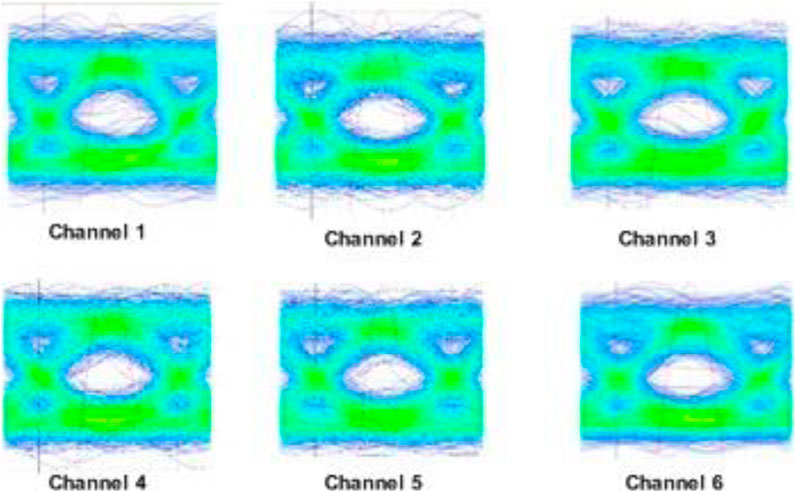- Navigation college, Quanzhou Normal University, Quanzhou, Fujian, China
Visible light communication (VLC) has been proven a promising technology to counter the limitations of radio frequency (RF) communication technology such as high interference and high latency issues. VLC offers high bandwidth as well as immunity to interference from other electromagnetic spectrums. Due to these features, VLC can be an excellent solution for biomedical and healthcare applications for transmission of body sensor signals and other crucial patient information. In this work, a highly efficient VLC system is designed to transmit six channels, with each one carrying 10 Gbps of data, over a 500 m optical fiber link and a 200 cm VLC link. To make the VLC system cost effective, simple and efficient on-off keying (OOK) (non-return to zero) is used as the encoding scheme. Moreover, to further enhance the capacity and bandwidth of the proposed VLC system, hybrid wavelength division multiplexing (WDM) and polarization division multiplexing (PDM) schemes are incorporated by using red, green, and blue lasers. The reported results show the successful transmission of all channels (6 × 10 Gbps) over 500 m optical fiber and 200 cm of VLC link.
Introduction
Incessant demand of higher data rates and multifold user support in existing networks has forced researchers to look beyond radio frequencies (RF), which are bandwidth-limited, toward optical wireless systems (OWC) that offer nearly unlimited bandwidth (>400 THz) via mounting an infrared and ultraviolet region of the electromagnetic spectrum [1]. Among different employed OWC systems, the visible light communication (VLC) system stands out as an apt future solution for terrestrial communication due to its ubiquitous influence and as light-emitting diodes (LEDs) are readily engaged in innumerable commercial applications ranging from lighting systems to multimedia display units in offices as well as homes, vehicles, and mobile phones. The VLC system offers innumerable features that consist of energy-efficient operation, higher data rates, zero RF or electromagnetic interference, and a physical layer of data security [2, 3]. Even with so many advantages, LEDs have a limited data rate due to strong internal polarization fields in common c-plane LEDs and hence are not considered suitable for higher speeds (in the gigabit range) [4–6]. Newly developed micro-LEDs offer a higher data rate in the order of 3 Gbps, but due to low illumination levels their use as light sources is not appropriate [7, 8]. On the other hand, laser diodes (LDs) have a high modulation bandwidth and high output power that allow them to be better candidates for proposing an optimum solution in a high-speed and long-reach VLC system [9]. Hu et al. displayed a VLC link with the link range of 300 m by using a 650-nm laser diode and data rate of 10 Mbps [10]. Another group of researchers reported construction of a WDM-VLC system over a link range of 10 m using red and green lasers with a 500 Mbps data rate [11]. Another work reported using a 450-nm laser diode and QAM-OFDM-based VLC over a range of 5 m for a data rate of 9 Gbps [12]. Wei et al. [13] demonstrated a RGB laser diode-based VLC system over a bidirectional 1 m. Yeh et al. [14] demonstrated a 1,250 Mbps VLC system using a yellow phosphorous LD over a range of 1 m. Advanced modulation formats such as OFDM or QAM used with VLC systems are proved to be better in terms of high data rate but with increased cost and complexity of the system. In order to keep the system at minimal cost, on-off keying (OOK) is proved to be efficient in terms of low complexity and cost effectiveness. In 2016, researchers demonstrated a 2-m VLC link with a data rate of 266 Kbps using OOK [15]. In 2017, Lu et al. reported a GaN-based VLC system employing NRZ-OOK with a 600 Mbps data rate over a transmission range of 0.6 m [16]. For harnessing VLC with indoor white lightning, a new type of red, green, and blue (RGB) LDs are employed. In 2011, researchers reported highly bright white light generated from LDs by mixing red, green blue, and yellow light components [17]. To enhance data rate, researchers have employed various multiplexing techniques namely wavelength division multiplexing (WDM), multiple input multiple output (MIMO), and polarization division multiplexing (PDM). In 2015 [18], Tsonev et al. proposed a 100 Gbps system using an RGB LD-based WDM-VLC system by using 36 parallel data streams. Chi et al. [19] in 2016 proposed and demonstrated an RGB LED-based VLC system with a PS-Manchester and WDM scheme with a data rate of 3.35 Gbps and a 1 m indoor transmission range. Another study in 2017 [20] proposed a WDM-based VLC system over a 1 m span with a data rate of 4.05 Gbps. Recently in 2020 [21], Messa et al. experimentally demonstrated detection of a WDM-VLC signal via a single photodiode with the use of MIMO signal processing. These studies conclude that implementation of RGB-LD-based WDM-VLC can significantly enhance system performance. For further enhancement of the capacity of the proposed system, another multiplexing technique is proposed such as the PDM technique. In 2015 [22], Kwoon et al. experimentally demonstrated enhancement of data rate up to 2.04 Gbps by employing the PDM scheme in the VLC system. Hsu et al. in 2018 [23] demonstrated an OFDM-PDM based VLC system with a data rate of 1.4 Gbps. Recently in 2020 [24], authors have demonstrated the transmission of 1.2 Gbps and 1.12 Gbps of data over a 3 and 4 m free space link by using dual polarized green and blue LED-based light streams. On the other hand, hybrid multiplexing schemes are used by many researchers to increase the bandwidth and capacity of optical communication systems [25–35]. In this work, the OOK modulation technique is used for realization of a low-cost VLC system. Further to increase the capacity of the system, hybrid WDM and PDM multiplexing schemes are proposed using RGB LDs. The remainder of this paper is described as follows: Hybrid WDM-PDM-VLC Modeling shows the modeling of the proposed WDM-PDM VLC system, Results and Discussion represents the results and discussion, and Conclusion shows the overall conclusion of this work.
Hybrid Wavelength Division Multiplexing-Polarization Division Multiplexing-Visible Light Communication Modeling
The schematic diagram of the proposed 6 × 10 Gbps hybrid WDM-PDM-based VLC system, modelled in OptiSystem software, is shown Figure 1.
As shown in Figure 1, six channels are transmitted by using hybrid WDM and PDM schemes. A red laser (650 nm), green laser (530 nm), and blue laser (450 nm) are used for the WDM scheme whereas X polarization with a 00 phase shift in azimuthal and Y polarization with a 900 phase shift in azimuthal are used for the PDM scheme. Each channel generates a pseudo random bit stream of 10 Gbps which is encoded using the NRZ modulation format and then the signal is fed to the directly modulated (DM) laser. To ensure the laser diode (LD) operates above threshold, a direct current (D.C.) bias is fed into it. The output of the first three channels are combined together and subjected to a 00 azimuthal phase (X polarization) whereas the output of the remaining three channels are combined and fed to the 900 phase shift in azimuthal (Y polarization). Figure 2 represents the measured optical spectrum of three channels for each state (X and Y polarizations).
These outputs from each polarization state are combined and transmitted over 500 m optical fiber and diffuser. For the modeling of the diffuse link, the transmitter source is assumed as a Lambertian disk which is irradiating a detector surface located at an axial distance h from the source. The Lambertian order which is based on transmitter half angle can be expressed mathematically as follows [36]:
whereas optical concentrator gain can be mathematically expressed as:
where I is defined as the internal refractive index of the lens and CR is defined as the field of view.
At the receiver side, a polarization splitter is used to de-multiplex the polarized signal for each state (X and Y polarizations). For each receiving channel, an avalanche photo diode (APD) is used to detect the light from the diffuser. The down-sampling frequency of APD is set to corresponding wavelengths transmitted at the transmitter side. The output of APD is amplified by using a trans-impedance amplifier followed by the low pass filter (LPF). At the output of LPF, bit error rate BER) is measured by using a bit error tester. The received signal at the receiver is expressed as [37, 38]:
where y(t) represents the received signal, x(t) represents the transmitted signal, h(t) represents the impulse response of the transmitted signal, and n(t) represents the additive noise which is composed of shot noise, thermal noise, and dark current noise. However, in this work, background noise is assumed to be negligible. The other modeling parameters considered for the proposed WDM-PDM-VLC link are mentioned in Table 1.
Results and Discussion
This section comprises the results from the modeling of the proposed WDM-PDM-VLC link. BER is used to evaluate the performance of the proposed WDM-PDM-VLC link. Figure 3 shows the computed BER for all the channels with respect to diffuse link range. It shows that channel 1 which is transmitted over 640 nm with X polarization and channel 4 which is transmitted over 650 nm with Y polarization achieved a BER of less than

FIGURE 3. Measured BER for each polarization channel, (A) channels 1 and 4, (B) channels 2 and 5, and (C) channels 3 and 6.
Channels 2 and 4 have also measured a BER of
Conclusion
In this work, six channels each carrying 10 Gbps of NRZ-encoded data are transmitted over a 500 m optical fiber and diffuse link range up to 200 cm by incorporating WDM and PDM schemes. RGB lasers are used for the WDM scheme whereas X and Y polarization states are used for the PDM scheme. For X polarization, an azimuthal phase shift of 00 is used whereas for Y polarization, a azimuthal phase shift of 900 is used. The performance of the proposed WDM-PDM-VLC link is evaluated in terms of BER and eye diagrams. The reported results show the successful transmission of all channels over a 500 m optical fiber link and 200 cm diffuse link with an acceptable BER
Data Availability Statement
The raw data supporting the conclusion of this article will be made available by the authors, without undue reservation.
Author Contributions
CX-P has conceived of the presented idea, designed the model and performed the computations and wrote the original draft.
Funding
This work is supported by Education and Scientific research project of middle and young teachers in Fujian (JAT200541).
Conflict of Interest
The author declares that the research was conducted in the absence of any commercial or financial relationships that could be construed as a potential conflict of interest.
Publisher’s Note
All claims expressed in this article are solely those of the authors and do not necessarily represent those of their affiliated organizations, or those of the publisher, the editors and the reviewers. Any product that may be evaluated in this article, or claim that may be made by its manufacturer, is not guaranteed or endorsed by the publisher.
References
1. Rahaim MB, Little TDC. Toward Practical Integration of Dual-Use VLC within 5G Networks. IEEE Wireless Commun (2015) 22:97–103. doi:10.1109/mwc.2015.7224733
2. Ghassemlooy Z, Alves LN, Zvanovec S, Khalighi M-A. In: Visible Light Communications: Theory and Applications. Florida, United States: CRC Press (2017).
3. Chaudhary S, Tang X, Ghassemlooy Z, Lin B, Wei X, Liaw S-K. "A 3× 25 Mbps WDM-Ro-VLC System for Amateur Radio Applications," in 2019 2nd West Asian Colloquium Opt Wireless Commun (Wacowc), 2019. p. 6–10.
4. Lin C, Lin B, Tang X, Shen X, Xu J, Chaudhary S. A Blur Equalization Method for Screen-To-Camera Based Optical Camera Communications. In: 18th International Conference on Optical Communications and Networks, 2019. Huangshan, China: ICOCN) (2019). p. 1–3. doi:10.1109/icocn.2019.8934224
5. Lin C, Lin B, Tang X, Zhou Z, Zhang H, Chaudhary S. Multilevel Brightness Modulation Scheme Based on a LED Array and K-Means Clustering Algorithm for Optical Camera Communications. In: 17th International Conference on Optical Communications and Networks (ICOCN2018) (2019). p. 1104820. doi:10.1117/12.2522829
6. Lin C, Lin B, Tang X, Zhou Z, Zhang H, Chaudhary S, et al. An Indoor Visible Light Positioning System Using Artificial Neural Network. In: Asia Communications and Photonics Conference, 2018. Hangzhou, China: ACP) (2018). p. 1–3. doi:10.1109/acp.2018.8596227
7. Rashidi A, Monavarian M, Aragon A, Rishinaramangalam A, Feezell D. Nonpolar ${m}$ -Plane InGaN/GaN Micro-scale Light-Emitting Diode with 1.5 GHz Modulation Bandwidth. IEEE Electron Device Lett (2018) 39:520–3. doi:10.1109/led.2018.2803082
8. Ferreira RXG, Xie E, McKendry JJD, Rajbhandari S, Chun H, Faulkner G, et al. High Bandwidth GaN-based Micro-LEDs for Multi-Gb/s Visible Light Communications. IEEE Photon Technol Lett (2016) 28:2023–6. doi:10.1109/lpt.2016.2581318
9. Wu T-C, Chi Y-C, Wang H-Y, Tsai C-T, Huang Y-F, Lin G-R. Tricolor R/G/B Laser Diode Based Eye-Safe White Lighting Communication beyond 8 Gbit/s. Sci Rep (2017) 7:11. doi:10.1038/s41598-017-00052-8
10. Hu G-y., Chen C-y., Chen Z-q. Free-space Optical Communication Using Visible Light. J Zhejiang Univ - Sci A (2007) 8:186–91. doi:10.1631/jzus.2007.a0186
11. Lin W-Y, Chen C-Y, Lu H-H, Chang C-H, Lin Y-P, Lin H-C, et al. 10m/500Mbps WDM Visible Light Communication Systems. Opt Express (2012) 20:9919–24. doi:10.1364/oe.20.009919
12. Chi Y-C, Hsieh D-H, Tsai C-T, Chen H-Y, Kuo H-C, Lin G-R. 450-nm GaN Laser Diode Enables High-Speed Visible Light Communication with 9-Gbps QAM-OFDM. Opt Express (2015) 23:13051–9. doi:10.1364/oe.23.013051
13. Wei L-Y, Hsu C-W, Chow C-W, Yeh C-H. “20.231 Gbit/s Tricolor red/green/blue Laser Diode Based Bidirectional Signal Remodulation Visible-Light Communication System," Photon Res (2018) 6:422. doi:10.1364/PRJ.6.000422
14. Yeh C-H, Chow C-W, Wei L-Y. 1250 Mbit/s OOK Wireless White-Light VLC Transmission Based on Phosphor Laser Diode. IEEE Photon J. (2019) 11:1–5. doi:10.1109/jphot.2019.2911411
15. Che F, Wu L, Hussain B, Li X, Yue CP. A Fully Integrated IEEE 802.15. 7 Visible Light Communication Transmitter with On-Chip 8-W 85% Efficiency Boost LED Driver. J Lightwave Technology (2016) 34:2419–30.
16. Lu Z, Tian P, Chen H, Baranowski I, Fu H, Huang X, et al. Active Tracking System for Visible Light Communication Using a GaN-based Micro-LED and NRZ-OOK. Opt Express (2017) 25:17971–81. doi:10.1364/oe.25.017971
17. Neumann A, Wierer JJ, Davis W, Ohno Y, Brueck SRJ, Tsao JY. Four-color Laser white Illuminant Demonstrating High Color-Rendering Quality. Opt Express (2011) 19:A982–A990. doi:10.1364/oe.19.00a982
18. Tsonev D, Videv S, Haas H. Towards a 100 Gb/s Visible Light Wireless Access Network. Opt Express (2015) 23:1627–37. doi:10.1364/oe.23.001627
19. Chi N, Zhang M, Zhou Y, Zhao J. 3375-Gb/s RGB-LED Based WDM Visible Light Communication System Employing PAM-8 Modulation with Phase Shifted Manchester Coding. Opt Express (2016/09/19 2016) 24:21663–73. doi:10.1364/oe.24.021663
20. Zhang M, Shi M, Wang F, Zhao J, Zhou Y, Wang Z, et al. 4.05-Gb/s RGB LED-Based VLC System Utilizing PS-Manchester Coded Nyquist PAM-8 Modulation and Hybrid Time-Frequency Domain Equalization. In: Optical Fiber Communication Conference. California, United States: W2A (2017). p. 42. doi:10.1364/ofc.2017.w2a.42
21. Messa A, Cossu G, Presi M, Schidl S, Schneider-Hornstein K, Zimmermann H, et al. Detecting WDM Visible Light Signals by a Single Multi-Color Photodiode with MIMO Processing. Opt Lett (2020/03/01 2020) 45:1160–3. doi:10.1364/ol.385641
22. Kwon D-H, Kim S-J, Yang S-H, Han S-K. Optimized Pre-equalization for Gigabit Polarization Division Multiplexed Visible Light Communication. Opt Eng (2015) 54:076101. doi:10.1117/1.oe.54.7.076101
23. Hsu C-W, Yeh C-H, Chow C-W. Using Adaptive Equalization and Polarization-Multiplexing Technology for Gigabit-Per-Second Phosphor-LED Wireless Visible Light Communication. Opt Laser Technology (2018) 104:206–9. doi:10.1016/j.optlastec.2018.02.004
24. Yang Y-C, Yeh C-H, Liaw S-K, Chow C-W, Hsu W-H, Wang B-Y, "Analysis and Investigation of Dual-Polarized Color LED Based Visible Light Communication System, in Photonics. 2021. p. 210. doi:10.3390/photonics8060210
25. Amphawan A, Chaudhary S, Neo T-K, Kakavand M, Dabbagh M. Radio-over-free Space Optical Space Division Multiplexing System Using 3-core Photonic crystal Fiber Mode Group Multiplexers. In: Wireless Networks (2020). p. 1–15. doi:10.1007/s11276-020-02447-4
26. Chaudhary S, Amphawan A. High-speed MDM-Ro-FSO System by Incorporating Spiral-Phased Hermite Gaussian Modes. Photon Netw Commun (2018) 35:374–80. doi:10.1007/s11107-017-0752-6
27. Chaudhary S, Lin B, Tang X, Wei X, Zhou Z, Lin C, et al. 40 Gbps-80 GHz PSK-MDM Based Ro-FSO Transmission System. Opt Quant Electron (2018) 50:321. doi:10.1007/s11082-018-1592-z
28. Chaudhary S, Sharma A. 6 X 20Gbps Long Reach WDM-PI Based High Altitude Platform Inter-satellite Communication System. Int J Computer Appl (2015) 122. doi:10.5120/21861-5192
29. Chaudhary S, Sharma A, Chaudhary N. 6× 20 Gbps Hybrid WDM–PI Inter-satellite System under the Influence of Transmitting Pointing Errors. J Opt Commun (2016) 37:375–9. doi:10.1515/joc-2015-0099
30. Chaudhary S, Sharma A, Tang X, Wei X, Sood P. A Cost Effective 100 Gbps FSO System under the Impact of Fog by Incorporating OCDMA-PDM Scheme. Wireless Personal Commun (2020) 1–10. doi:10.1007/s11277-020-07784-3
31. Chaudhary S, Tang X, Sharma A, Lin B, Wei X, Parmar A. A Cost-Effective 100 Gbps SAC-OCDMA-PDM Based Inter-satellite Communication Link. Opt Quant Electron (2019) 51:148. doi:10.1007/s11082-019-1864-2
32. Chaudhary S, Tang X, Wei X. Comparison of Laguerre-Gaussian and Donut Modes for MDM-WDM in OFDM-Ro-FSO Transmission System. AEU - Int J Electronics Commun (2018) 93:208–14. doi:10.1016/j.aeue.2018.06.024
33. Sarangal H, Singh A, Malhotra J, Chaudhary S. A Cost Effective 100 Gbps Hybrid MDM-OCDMA-FSO Transmission System under Atmospheric Turbulences. Opt Quant Electron (2017) 49:184. doi:10.1007/s11082-017-1019-2
34. Upadhyay KK, Shukla NK, Chaudhary S. A High Speed 100 Gbps MDM-SAC-OCDMA Multimode Transmission System for Short Haul Communication. Optik (2020) 202:163665. doi:10.1016/j.ijleo.2019.163665
35. Upadhyay KK, Srivastava S, Shukla NK, Chaudhary S. High-speed 120 Gbps AMI-WDM-PDM Free Space Optical Transmission System. J Opt Commun (2019) 40:429–33. doi:10.1515/joc-2017-0086
36. Kahn JM, Barry JR. Wireless Infrared Communications. Proc IEEE (1997) 85:265–98. doi:10.1109/5.554222
37. Qiu Y, Chen H-H, Meng W-X. Channel Modeling for Visible Light Communications-A Survey. Wirel Commun Mob Comput (2016) 16:2016–34. doi:10.1002/wcm.2665
Keywords: visible light communication, wavelengh-division multiplexing (WDM), polarization division multiplexing (PDM), on off keying, biomedical application
Citation: Xiang-Peng C (2021) A Cost-Efficient RGB Laser-Based Visible Light Communication System by Incorporating Hybrid Wavelength and Polarization Division Multiplexing Schemes. Front. Phys. 9:731405. doi: 10.3389/fphy.2021.731405
Received: 27 June 2021; Accepted: 05 July 2021;
Published: 26 August 2021.
Edited by:
Santosh Kumar, Liaocheng University, ChinaReviewed by:
Muhammad Saadi, University of Central Punjab, PakistanJawad Raza, National College of Business Administration and Economics, Pakistan
Copyright © 2021 Xiang-Peng. This is an open-access article distributed under the terms of the Creative Commons Attribution License (CC BY). The use, distribution or reproduction in other forums is permitted, provided the original author(s) and the copyright owner(s) are credited and that the original publication in this journal is cited, in accordance with accepted academic practice. No use, distribution or reproduction is permitted which does not comply with these terms.
*Correspondence: CAI Xiang-Peng, Y3hwMjYzMjYzQDE2My5jb20=
 CAI Xiang-Peng
CAI Xiang-Peng


